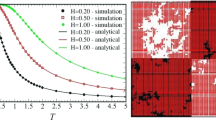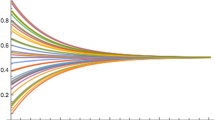Abstract:
The dynamics of spreading of the minority opinion in public debates (a reform proposal, a behavior change, a military retaliation) is studied using a diffusion reaction model. People move by discrete step on a landscape of random geometry shaped by social life (offices, houses, bars, and restaurants). A perfect world is considered with no advantage to the minority. A one person-one argument principle is applied to determine locally individual mind changes. In case of equality, a collective doubt is evoked which in turn favors the Status Quo. Starting from a large in favor of the proposal initial majority, repeated random size local discussions are found to drive the majority reversal along the minority hostile view. Total opinion refusal is completed within few days. Recent national collective issues are revisited. The model may apply to rumor and fear propagation.
Similar content being viewed by others
Author information
Authors and Affiliations
Additional information
Received 23 January 2002
Rights and permissions
About this article
Cite this article
Galam, S. Minority opinion spreading in random geometry. Eur. Phys. J. B 25, 403–406 (2002). https://doi.org/10.1140/epjb/e20020045
Issue Date:
DOI: https://doi.org/10.1140/epjb/e20020045




